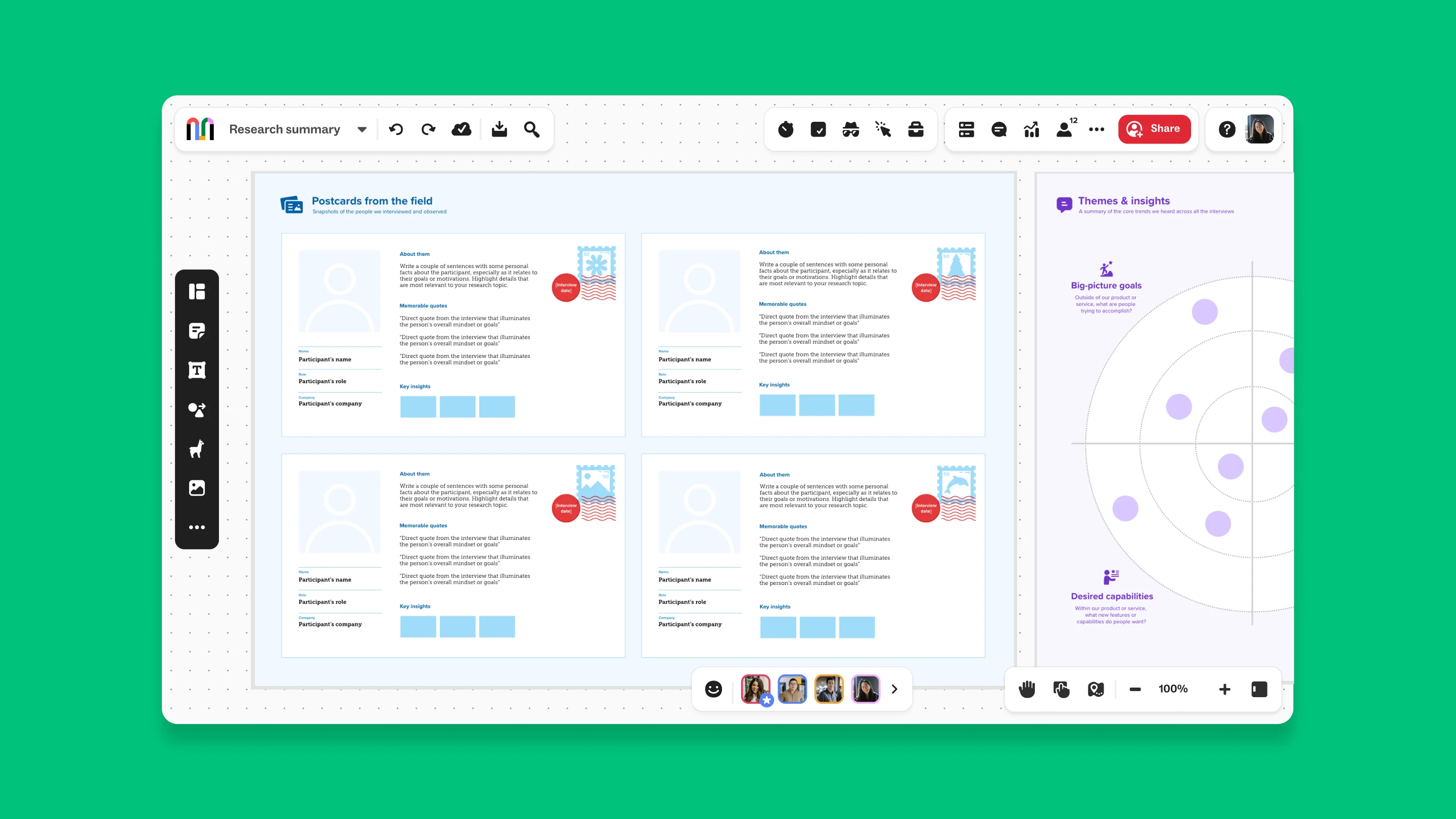On this page
Use Research synthesis template
Get started
Visualize findings to inform next steps

In R&D, your ability to move fast depends on how quickly you can make sense of findings. The research synthesis template gives your team a central space to consolidate user research notes, sort and summarize them, and translate insights into next steps. You can quickly identify common themes, map them to product goals, and prioritize a plan of action that will result in faster outcomes.
Rapidly distill large volumes of qualitative data into usable chunks.
Understand how testers interact with prototypes and new features.
Spot quick wins for feature optimization before or after launch.
Accelerate speed to market for product releases and updates.
Reach alignment on a data-backed product roadmap.
Start by filling out a postcard from the field for each interviewee. Summarize who they are, what motivates them, and the context of their goals. Include memorable quotes and key insights that represent their mindset or challenges.
Review your postcards and highlight the strongest ideas, quotes, and takeaways that reflect user needs or frustrations. Mural AI’s summarize feature can help condense long notes into concise insights.
Scan across your postcards to identify recurring patterns in goals, pain points, and motivations. Combine similar insights and note the most common threads you observe.
Use the Themes & insights radar to visualize your interview insights. Plot big-picture goals, pain points, desired capabilities, and opportunities for impact, placing the most important insights closest to the center.
Use connector lines or visual links to show relationships between insights on the radar. Notice where clusters form, as these often point to your strongest opportunities for improvement or innovation.
Review the radar and decide where to focus first. Identify the most promising opportunities for impact and outline immediate actions to explore or prototype them.

During beta cycles, issues and opportunities surface quickly. By synthesizing tester feedback in a structured way, your team can spot recurring usability problems, discover unexpected user behaviors, and make targeted improvements before launch. This helps you hit development milestones without surprise delays.
Even promising new features can fall short if small pain points go unnoticed. Using the synthesis template, you can compare qualitative feedback and sentiment patterns to refine workflows, tweak copy, or adjust UI elements. Backed by research, your features will ship with higher adoption and fewer post-launch fixes needed.
R&D teams often receive a flood of ideas and enhancement requests. The synthesis template helps turn different feedback into a prioritized backlog. It maps suggestions to business goals and user needs so the most important changes make it into upcoming sprints.
Paste text into your canvas directly from interview notes or transcripts to avoid missing details.
Use the Mural AI summarize feature to condense long transcripts into concise snippets that will fit in your postcards.
Use the classify AI feature to quickly gauge sentiment and group feedback by theme.
Share your research synthesis mural with multiple stakeholders to align priorities asynchronously or in real time.
Highlight impact quotes as quick reminders of specific users’ input and to help other readers get up to speed at a glance.
The template provides a central space to consolidate user research notes, sort and summarize them, and translate findings into clear next steps. It helps R&D teams distill large volumes of qualitative data into usable chunks, understand how testers interact with new features, align on action items, and improve speed to market for product releases and updates.
The template contains sections in which you can summarize interview and test results, extract major themes, identify jobs to be done, map the user journey with sticky notes, generate a feature list from feedback, and decide on next steps. It also includes options to modify the workflow to fit your team’s process and suggestions for related templates to support your research efforts.
Start by copying insights directly from interview notes or transcripts into the template. Use Mural AI summarize to condense lengthy content into bite-sized takeaways, then employ Mural AI classify to organize findings by sentiment or theme. From there, identify impact quotes and key patterns, document them, and work with your team to map user journeys and prioritize action items.
Over 95% of the Fortune 100 use Mural to get things done.
No credit card required





